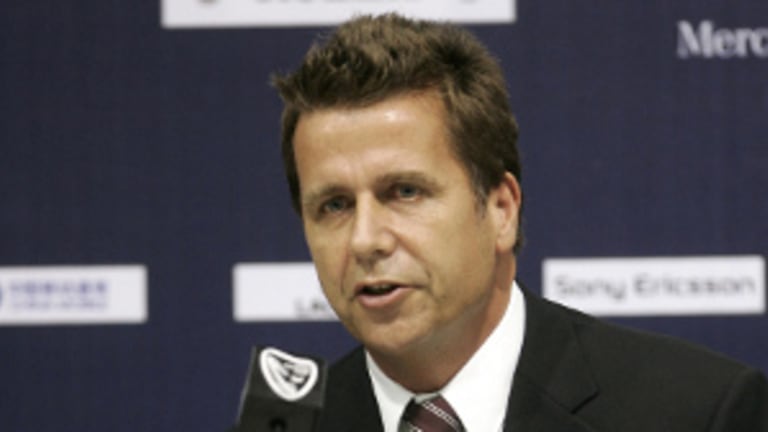What are the four major issues in tennis as we approach the fourth and final major of the season? The Grand Stories, written by Steve Tignor and Peter Bodo:
**Monday, August 19: Serena's Strengths vs. Serena's Struggles
Tuesday, August 20: The Summer of Rafa
Wednesday, August 21: Bryan Brothers Seek Slam
Friday, August 23: The Open's Economic Issues**
NEW YORK—You social media junkies needn’t fret should you leave your cell phones, tablets, and other hand-held devices at home by mistake when you attend the U.S. Open. One of the most visible cosmetic changes at the American Grand Slam will be a 50-foot long, eight-foot tall, “digital” wall (and you thought your screen size was adequate?) that will constantly display and refresh postings culled from Twitter, Facebook and Instagram.
“We want to capture and aggregate the social medial swirling around the U.S. Open,” USTA communications chief Chris Widmaier told me the other day. “Technology is the big driver in sports today and we want to be on top of that.”
While keyboard punchers are likely to spend way too much time gawking at the digital wall, hoping that their tweet or Facebook update appears briefly on it, the rest of the fan nation will get an extra day of tennis as the U.S. Open joins the French Open as a 15-day Grand Slam this year.
The players received a hefty raise this year (more on that later), and one rider attached to this leap in compensation is that the tournament will go one day longer, with the men’s final on Monday evening—start time: 5 p.m. That’s part of a gradual transition that will finally bring the U.S. Open in line with the other majors, with a one-day interval between the semis and finals for both the men and women. It rings the death knell for an idea that surely has outlived its usefulness, entertaining as it once was: Super Saturday.
This year, the men’s semis will be held on Saturday (as per usual), but the women will take over that much criticized Sunday 4 p.m. start time for their championship match, and the men end the tournament on Monday.
“Gradual transition” is a useful term when it comes to the U.S. Open, and not just in terms of dismantling the Super Saturday scheme. The very largest change this year is a great shift in the vision of the USTA regarding the U.S. Open, rather than the reality of the pending event. The organization has just crossed a Rubicon into which it had first thrust a toe a decade ago, when it first began exploring the option of putting a roof on Arthur Ashe stadium.
At the time, a retro-fit was deemed impossible. But over the years, as the clamor for the roof grew, the determination to find a solution also matured. That was driven by at least three critical factors: the Australian Open’s groundbreaking experiment with two tennis arenas featuring retractable roofs, Wimbledon’s addition of a retractable roof over Centre Court in 2009 (“If that fortress of tradition can do it, why can’t we?” the USTA seemed to conclude), and—last but not least—five consecutive washouts (and counting) that forced re-scheduling the U.S. Open men’s final from Sunday to Monday.
Somebody up there clearly was trying to tell the USTA something.
The USTA finally listened.
“We feel that we now have a design that meets the criteria of being architecturally sound, aesthetically pleasing, reasonably affordable and buildable,” USTA chairman of the board and president Dave Haggerty said when unveiling the plans. “We have been working toward a viable design for a roof over Arthur Ashe Stadium for a decade.”
The roof will be supported by eight steel columns erected around Ashe. It will be made of a flexible, translucent Teflon fabric (PTFE) stretched over a steel frame. It’s a handsome thing, at least in the architectural renderings. The overlapping panels look like sails borrowed and adapted from an enormous sailboat, or like the Sydney Opera House plopped down on its side on top of Ashe.
The roof is part of a massive renovation of the USTA Billie Jean King National Tennis Center. The roof will cost $100 million, give or take; the entire re-design will come in at (the USTA hopes) about $500 million. The wish list with that price tag includes two new stadia, to replace the aged and outdated Grandstand and Louis Armstrong complex (the “new” Armstrong will have a retractable roof, too).
You probably don’t want to get too deep into the weeds on this stuff, but the USTA presently has enormous crowding problems at the main or East gate. (“Our front door,” Widmaier said. “Ninety percent of our traffic comes through there.”) For that reason the area there will be greatly expanded and the hulking Grandstand, which is now the cause of much of that congestion, will be re-born as a stand-alone third stadium over to the south, well out of the way.
Some of the other fan-friendly infrastructural changes will be a new, elevated viewing platform from which fans will be able to look out over five practice courts on one side and five tournament courts on the other. It will exist pretty much where the main practice courts are now, near the West entrance. The decision to build it shows that the organization does have its ear to the ground when it comes to what fans like and want.
The disappointing thing in all this is that the makeover will take five years (Wimbledon got its roof built and installed in just three), which is a pretty long lead time. But at least the USTA is hoping to get that practice-court/viewing area renovation completed by next year’s tournament.
